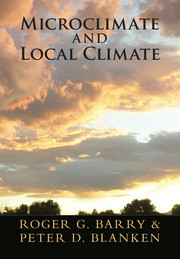Book contents
- Frontmatter
- Contents
- Preface
- Acknowledgments
- 1 Introduction
- Part I Controls of Microclimate
- 2 Microclimatic Elements
- 3 Methods of Observation and Instrumentation
- 4 Radiation
- 5 The Energy Balance
- 6 Monitoring Radiation, Energy, and Moisture Balance via Remote Sensing and Modeling with Land Surface Models
- 7 Microclimates of Different Vegetated Environments
- 8 Microclimates of Physical Systems
- 9 Bioclimatology
- Part II Local (Topo-)Climates
- Part III Environmental Change
- Problems
- Glossary
- Symbols
- System International (SI) Units and Conversions
- Index
- References
6 - Monitoring Radiation, Energy, and Moisture Balance via Remote Sensing and Modeling with Land Surface Models
from Part I - Controls of Microclimate
Published online by Cambridge University Press: 05 May 2016
- Frontmatter
- Contents
- Preface
- Acknowledgments
- 1 Introduction
- Part I Controls of Microclimate
- 2 Microclimatic Elements
- 3 Methods of Observation and Instrumentation
- 4 Radiation
- 5 The Energy Balance
- 6 Monitoring Radiation, Energy, and Moisture Balance via Remote Sensing and Modeling with Land Surface Models
- 7 Microclimates of Different Vegetated Environments
- 8 Microclimates of Physical Systems
- 9 Bioclimatology
- Part II Local (Topo-)Climates
- Part III Environmental Change
- Problems
- Glossary
- Symbols
- System International (SI) Units and Conversions
- Index
- References
Summary
The previous discussion has focused on the measurement of components of the radiation and energy balances at a small scale, such as a field. However, these data do not provide a basis for scaling up to large geographical areas such as watersheds or biomes, or globally. Over the last three decades this problem has increasingly been addressed by the application of multispectral remote sensing techniques. Here, we describe these approaches. This is followed by discussion of land surface models leading on to the topic of downscaling model outputs to small-scale conditions.
Microclimatic models have evolved over the last 20–30 years from empirical, statistical correlation-based approaches to physical models that are incorporated into landscape models and urban structure models. Here we briefly introduce the principal empirical and physical models that are in use.
Approaches
Microclimatic research was for most of its history carried out at a few sites for limited time intervals. However, the scaling up of results from field studies has become a focus of attention in the last two to three decades. This has been made possible by the application of high-resolution remote sensing data and by numerical modeling.
Courault et al. (2005) identify three general categories of approach that incorporate remote sensing data: (i) direct empirical methods, (ii) combined empirical and physically based methods, and (iii) soil-vegetation-atmosphere-transfer (SVAT) schemes.
Empirical Direct Methods
One of the most basic approaches is the remote sensing of leaf area index (LAI). It is defined as the one-sided green leaf area per unit ground surface area (square meters per square meter) in broadleaf canopies, while in conifer canopies, three different definitions for LAI have been used: half of the total needle surface area per unit ground surface area, projected (or one-sided) needle area per unit ground area, and total needle surface area per unit ground area. LAI ranges from 0 over bare ground to more than 10 for dense conifer forests. LAI is a significant indicator of energy and mass exchange by plant canopies and is useful to scale from the leaf to canopy-level measurements. Its importance was recognized by the National Research Council (1986, p. 102) as “the key to studying vegetation biomass and productivity from space.”
One of the first studies of LAI via remote sensing was that of Curran (1983).
Information
- Type
- Chapter
- Information
- Microclimate and Local Climate , pp. 126 - 147Publisher: Cambridge University PressPrint publication year: 2016
